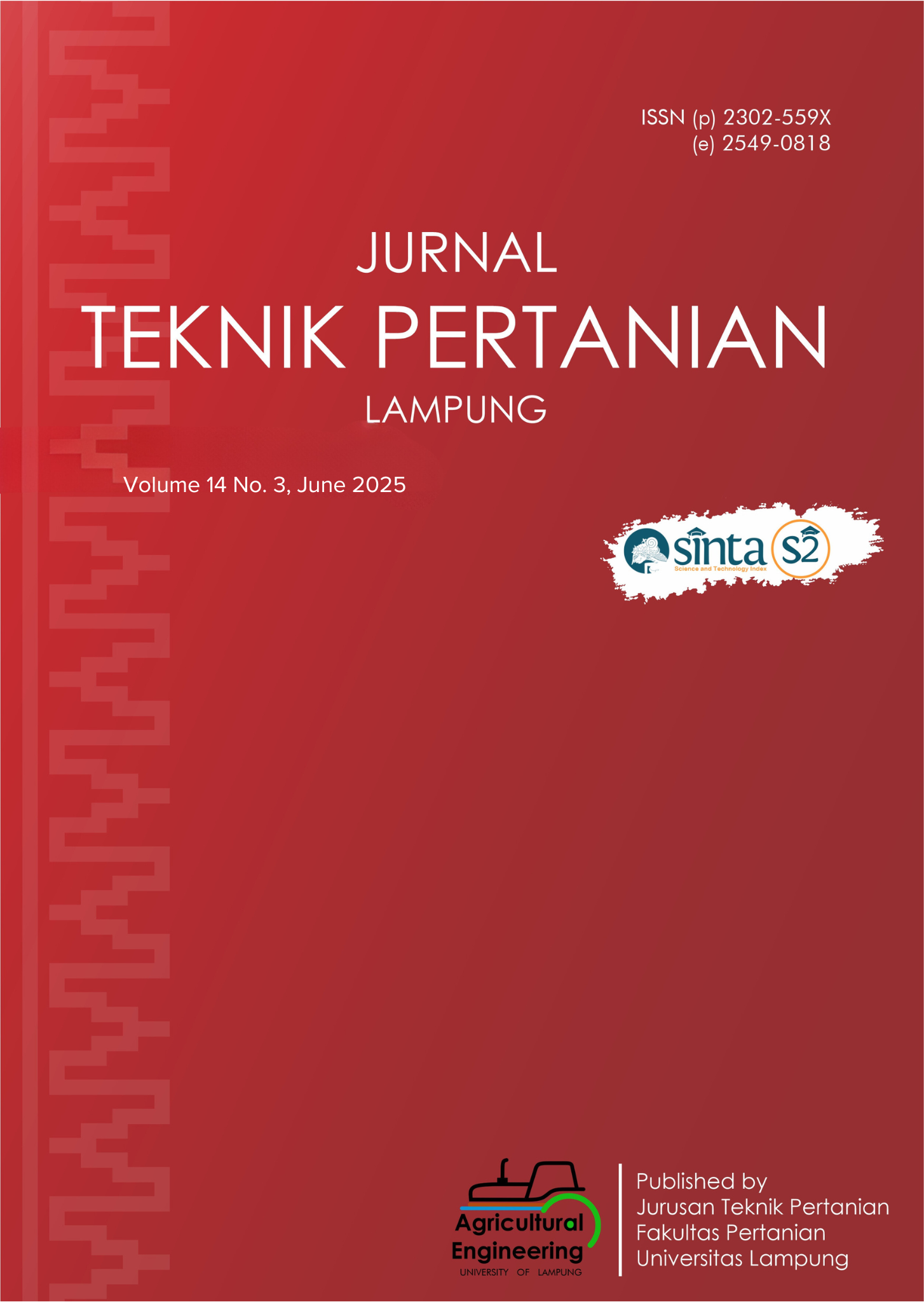Bangka Sago as A Superior Starch Source: Processing, Morphology, Chemical Properties, and Heavy Metal Content
DOI:
https://doi.org/10.23960/jtep-l.v14i3.789-802 Abstract View: 220
Abstract View: 220
Abstract
Indonesia has significant potential for food diversification through the development of sago as an alternative carbohydrate source. This study aims to analyze the processing methods, morphological characteristics, chemical properties, and heavy metal content of local sago in Bangka and Bangka Tengah Regencies. The research was conducted across six villages from November 2023 to March 2024, with chemical and heavy metal testing performed in accredited laboratories. The results indicate that modern processing methods produce high quality starch with a starch content ranging from 79.06% to 83.73% and heavy metal levels such as tin (Sn), lead (Pb), and cadmium (Cd) below the established safety limits, making it safe for consumption. Morphologically, habitat differences influence the physical characteristics of sago, such as trunk height, bark thickness, and leaf area, which affect starch productivity. The study also identifies that environmental factors, including nutrient availability and soil moisture levels, influence the chemical composition of sago. This research provides a scientific foundation for the integrated management of sago, supporting national food diversification efforts and opening opportunities for the development of sago based products that meet national quality standards (SNI) with an environmentally friendly approach. These findings are relevant for stakeholders in optimizing sago's potential as a strategic commodity contributing to national food security.
Keywords: Food diversification, Heavy metal, Sago, Starch content, Sustainable agriculture.
Downloads
References
Ahmad, A.N., Lim, S.A., Navaranjan, N., Hsu, Y-I., & Uyama, H. (2020). Green sago starch nanoparticles as reinforcing material for green composites. Polymer, 202, 122646. https://doi.org/10.1016/j.polymer.2020.122646
Alemayehu, G. F., Forsido, S. F., Tola, Y. B., Teshager, M. A., Assegie, A. A., & Amare, E. (2021). Proximate, mineral and anti nutrient compositions of oat grains (Avena sativa) cultivated in Ethiopia: Implications for nutrition and mineral bioavailability. Heliyon, 7(8), 1–8. https://doi.org/10.1016/j.heliyon.2021.e07722
Ayulia, L., Djoefrie, M.H.B., & Arifien, Y. (2021). Vegetative morphology and starch production among sago plants (Metroxylon spp.) Kepulauan Meranti District, Riau, Indonesia. Journal of Tropical Crop Science, 8(1), 33–40. https://doi.org/10.29244/JTCS.8.01.33-40
Babelprov. (2023). Pengamatan Unsur Iklim di Stasiun Pengamatan Badan Meteorologi dan Geofisika (BMKG). https://sdi.babelprov.go.id/sektoral/elemen/periode/6215A2352C1D6/2023 Botanri, S. (2015). Preferensi habitat dan adaptasi tumbuhan sagu (Metroxylon spp) di Pulau Seram Provinsi Maluku. Prosiding Seminar Nasional Penguatan Pembangunan Berbasis Riset Perguruan Tinggi.
BPS (Badan Pusat Statistik). (2023). Provinsi Kepulauan Bangka Belitung Dalam Angka 2023. Badan Pusat Statistik Provinsi Bangka Belitung. Gaitán-Cremaschi, D., Klerkx, L., Duncan, J., Trienekens, J.H., & Huenchuleo, C., Dogliotti, S., Contesse, M.E., Rossing, W.A.H. (2019). Characterizing diversity of food systems in view of sustainability transitions. A review. Agronomy for Sustainable Development, 39(1), 1–22. https://doi.org/10.1007/s13593-018-0550-2
Dewayani, W., Mahendradatta, M., & Laga, A. (2024). Post-harvest handling of sago and the sustainability of the processed results. BIO Web of Conferences, 96, 02001. https://doi.org/10.1051/bioconf/20249602001
Djoefrie, M.H.B., Herodian, S., Ngadiono, Thoriq, A., & Amarillis, S. (2014). Sagu untuk kesejahteraan masyarakat Papua: Suatu kajian dalam upaya pengembangan sagu sebagai komoditas unggulan di Provinsi Papua dan Provinsi Papua Barat. Unit Percepatan Pembangunan Papua dan Papua Barat.
Du, C., Jiang, F., Jiang, W., Ge, W., & Du, S-k. (2020). Physicochemical and structural properties of sago starch. International Journal of Biological Macromolecules, 164(1), 1785–1793. https://doi.org/10.1016/j.ijbiomac.2020.07.310
Ickowitz, A., Powell, B., Rowland, D., Jones, A., & Sunderland, T. (2019). Agricultural intensification, dietary diversity, and markets in the global food security narrative. Global Food Security, 20(1), 9–16. https://doi.org/10.1016/j.gfs.2018.11.002
Li, Z., & Wei, C. (2020). Morphology, structure, properties and applications of starch ghost: A review. International Journal of Biological Macromolecules, 163(1), 2084–2096. https://doi.org/10.1016/j.ijbiomac.2020.09.077
Maherawati., Lestari, R.B., & Haryadi. (2011). Karakteristik pati dari batang sagu Kalimantan Barat pada tahap pertumbuhan yang berbeda. AGRITECH, 31(1), 9–13. https://jurnal.ugm.ac.id/agritech/article/view/9720/7295
Octavia, D., Suharti, S., Murniati., Dharmawan, I.W.S., Nugroho, H.Y.S.H., Supriyanto, B., Rohadi, D., Njurumana, G.N., Yeny, I., Hani, A., Mindawati, N., Suratman., Adalina, Y., Prameswari, D., Hadi, E.E.W., & Ekawati, S. (2022). Mainstreaming smart agroforestry for social forestry implementation to support sustainable development goals in Indonesia: A Review. Sustainability, 14(15), 1–29. https://doi.org/10.3390/su14159313
Polnaya, F.J., Huwae, A.A., & Tetelepta, G. (2018). Karakteristik sifat fisiko-kimia dan fungsional pati sagu ihur (Metroxylon sylvestre) dimodifikasi dengan hidrolisis asam. Agritech, 38(1), 7–15. https://doi.org/10.22146/agritech.16611
Purbaningsih, Y., Bafadal, A., & Sutariati, G.A.K. (2019). An analysis of the comparative and competitive advantage of sago processing business. IOP Conference Series: Earth and Environmental Science, 382, 012036. https://doi.org/10.1088/1755 1315/382/1/012036
Rahmawati, S., Wahyuni, S., Khaeruni, A. (2019). Pengaruh modifikasi terhadap karakteristik kimia tepung sagu termodifikasi : Studi kepustakaan, The effect of modification process on the chemical characteristics of modified sago flour: A review. Jurnal Sains dan Teknologi Pangan, 4(2), 2096–2103. https://ojs.uho.ac.id/index.php/jstp/article/view/7129/5288
Santoso, A.D. (2018). Potensi dan kendala pengembangan sagu sebagai bahan pakan, pangan, energi dan kelestarian lingkungan di Indonesia. Jurnal Rekayasa Lingkungan, 10(2), 51–57. Schneider, P., & Asch, F. (2020). Rice production and food security in Asian Mega deltas—A review on characteristics, vulnerabilities and agricultural adaptation options to cope with climate change. Journal of Agronomy and Crop Science, 206(4), 491–503. https://doi.org/10.1111/jac.12415
Selvarajan, E., Veena, R., & Kumar, N.M. (2018). Microbial bioprospecting for sustainable development. Springer Singapore, 203 222.
Sheil, D., Boissière, M., van Heist, M., Rachman, I., Basuki, I., Wan, M., & Watopa, Y. (2021). The floodplain forests of the mamberamo basin, papua, indonesia (Western new guinea): Vegetation, soils, and local use. Forests, 12(12), 1–26. https://doi.org/10.3390/f12121790
Sugeng, S., & Fitria, A. (2023). Food sovereignty for Indonesia: The epistemological dimension of knowledge and variety of local food. Jurnal Analisis Hukum, 6(1), 18–32. https://doi.org/10.38043/jah.v6i1.4179
Sumardiono, S., Budiyono, B., Kusumayanti, H., Silvia, N., Luthfiani, V.F., & Cahyono, H. (2021). Production and physicochemical characterization of analog rice obtained from sago flour, mung bean flour, and corn flour using hot extrusion technology. Foods, 10(12), 1–15. https://doi.org/10.3390/foods10123023
Susanto, B., Tosuli, Y.T., Adnan., Cahyadi., Nami, H., Surjosatyo, A., Alandro, D., Nugroho, A.D., Rashyid, M.I., & Muflikhun, M. A. (2024). Characterization of sago tree parts from Sentani, Papua, Indonesia for biomass energy utilization. Heliyon, 10(1), 1 22. https://doi.org/10.1016/j.heliyon.2024.e23993
Syartiwidya, S. (2023). Potensi sagu (Metroxylon Sp.) dalam mendukung ketahanan pangan di Provinsi Riau. Selodang Mayang: Jurnal Perencanaan Pembangunan Daerah Kabupaten Indragiri Hilir, 9(1), 77–84. https://doi.org/10.47521/selodangmayang.v9i1.277
Toromade, A.S., Soyombo, D.A., Kupa, E., & Ijomah, T.I. (2024). Reviewing the impact of climate change on global food security: Challenges and solutions. International Journal of Applied Research in Social Sciences, 6(7), 1403–1416. https://doi.org/10.51594/ijarss.v6i7.1300
Trisia, M.A., Metaragakusuma, A.P., Osozawa, K., & Bai, H. (2016). Promoting sago palm in the context of national level: Challenges and strategies to adapt to climate change in Indonesia. International Journal of Sustainable Future for Human Security, 4(2), 54–63. https://doi.org/10.24910/jsustain/4.2/5463
Trisia, M.A., Tachikawa, M., & Ehara, H. (2021). The role of the sago supply chain for rural development in Indonesia. Reviews in Agricultural Science, 9(1), 143–156. https://www.jstage.jst.go.jp/article/ras/9/0/9_143/_html/-char/en
Zou, W., Sissons, M., Gidley, M.J., Gilbert, R.G., & Warren, F.J. (2015). Combined techniques for characterising pasta structure reveals how the gluten network slows enzymic digestion rate. Food Chemistry, 188(1), 559–568. https://doi.org/10.1016/j.foodchem.2015.05.032
Downloads
Published
How to Cite
Issue
Section
License
Authors who publish with this journal agree to the following terms:
Authors retain copyright and grant the journal right of first publication with the work simultaneously licensed under a Creative Commons Attribution-ShareAlike 4.0 International Lice that allows others to share the work with an acknowledgement of the work's authorship and initial publication in this journal.
Authors are able to enter into separate, additional contractual arrangements for the non-exclusive distribution of the journal's published version of the work (e.g., post it to an institutional repository or publish it in a book), with an acknowledgement of its initial publication in this journal.
Authors are permitted and encouraged to post their work online (e.g., in institutional repositories or on their website) prior to and during the submission process, as it can lead to productive exchanges, as well as earlier and greater citation of published work (See The Effect of Open Access).
Jurnal Teknik Pertanian Lampung

JTEPL is licensed under a Creative Commons Attribution-ShareAlike 4.0 International License.













